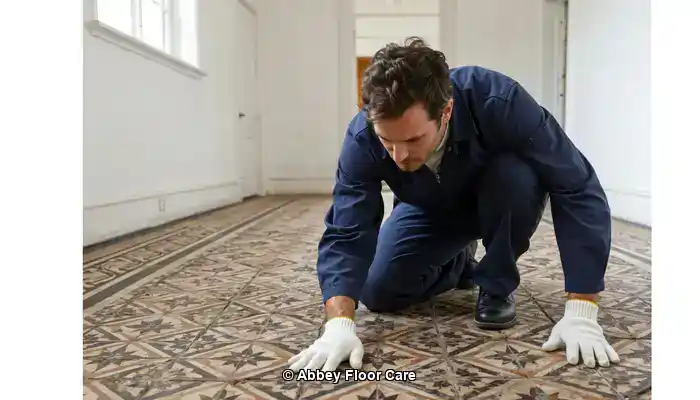
Last Updated on October 30, 2025 by David
Discover Key Takeaways from the Article, “Revitalising Colour and Pigment in Victorian Mosaic Tiles”:
- Victorian mosaic tiles frequently lose their colour because of ingrained dirt, previous coatings, and surface wear, significantly diminishing their visual allure and historical authenticity. Understanding these contributing factors is essential for effective restoration.
- Harsh chemicals and aggressive scrubbing can strip original pigments, particularly on encaustic and geometric tiles, leading to irreversible damage that detracts from their heritage value and aesthetic appeal.
- Safe restoration begins with a thorough cleaning process that utilises pH-neutral solutions and low-speed rotary machines equipped with soft brushes, providing effective yet gentle treatment that preserves tile integrity.
- Old sealers and waxes must be meticulously removed to reveal the true condition of the tile surface, allowing for a precise assessment and restoration to its former glory.
- Colour enhancement can be achieved through breathable, stone-safe sealers that deepen tones without creating a glossy finish, thereby maintaining the tiles’ natural, authentic appearance.
- Professional restoration can rejuvenate original pigments effectively without the need for repainting or artificial colouring, preserving the authenticity of these historic tiles for future generations.
- Maintaining restored tiles requires gentle cleaning routines and the avoidance of acidic or bleach-based products that can harm the tile surface, ensuring their longevity and beauty.
- Heritage-sensitive methods protect both the aesthetic and historical value of these exquisite tiles, guaranteeing their durability and appreciation for future generations.
Uncovering Advanced Techniques for Restoring Victorian Tiles
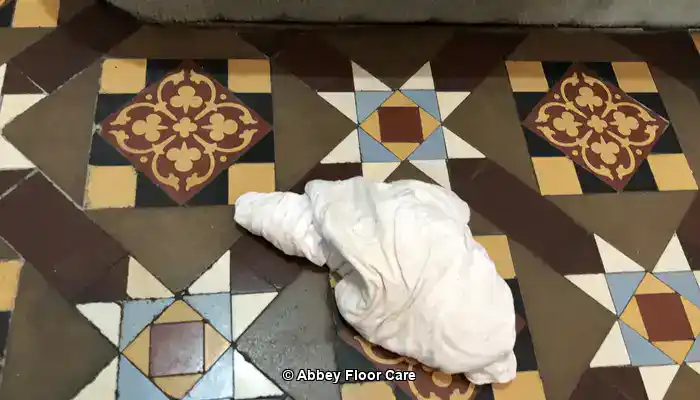
Victorian encaustic and mosaic tiles represent more than just decorative elements; they are a significant reflection of British architectural heritage. These tiles are prized for their exquisite craftsmanship and distinctive colour palettes, crafted from mineral pigments that are fused directly into the clay tile bodies. This unique combination of artistry and material not only enhances visual appeal but also conveys the historical context in which they were created. Gaining insight into the history and craftsmanship of these tiles can enrich appreciation and guide careful restoration efforts that honor their legacy and maintain their value.
Expert Guidance for Daily Care of Victorian Tiles
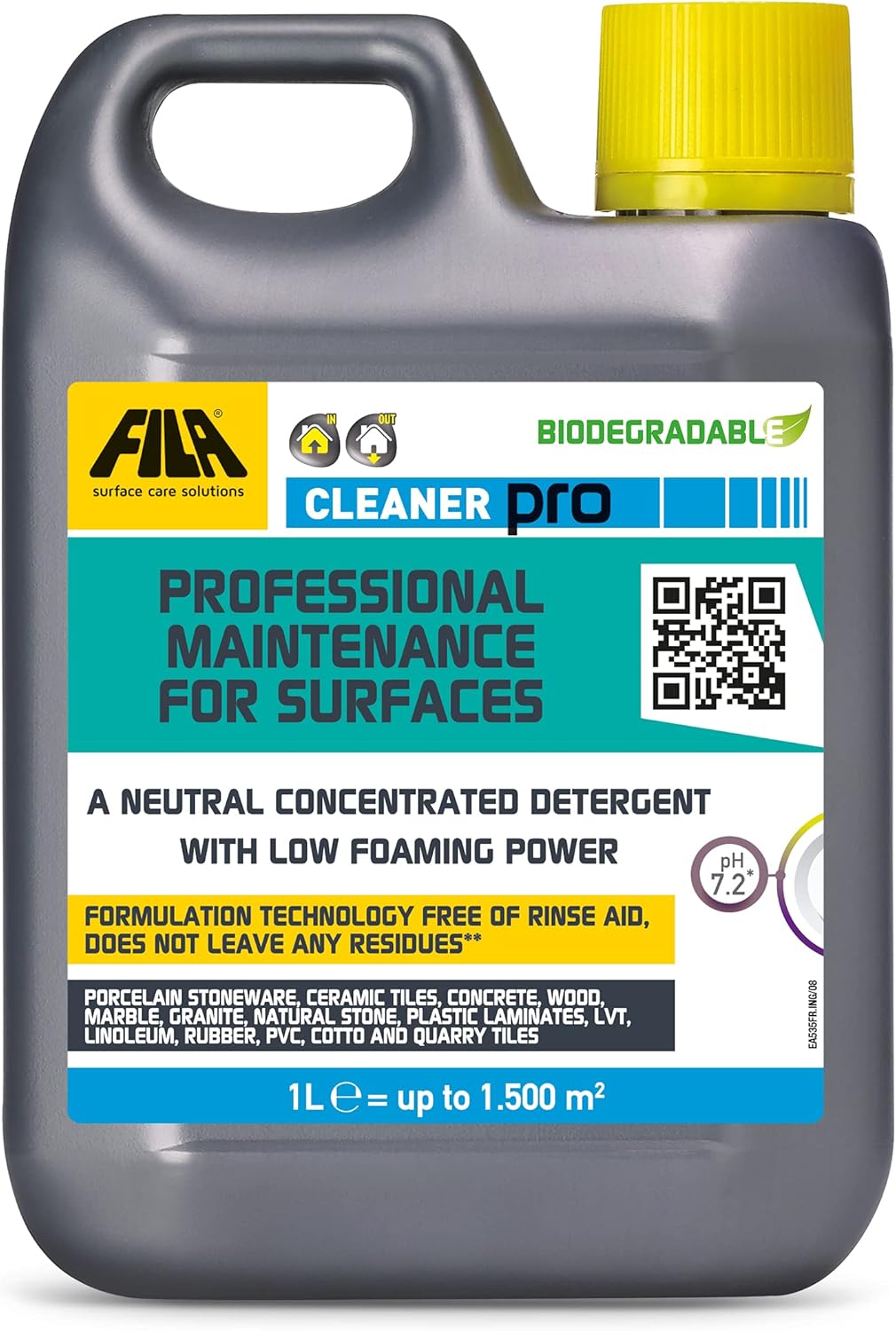
Fila Pro Floor Cleaner
|
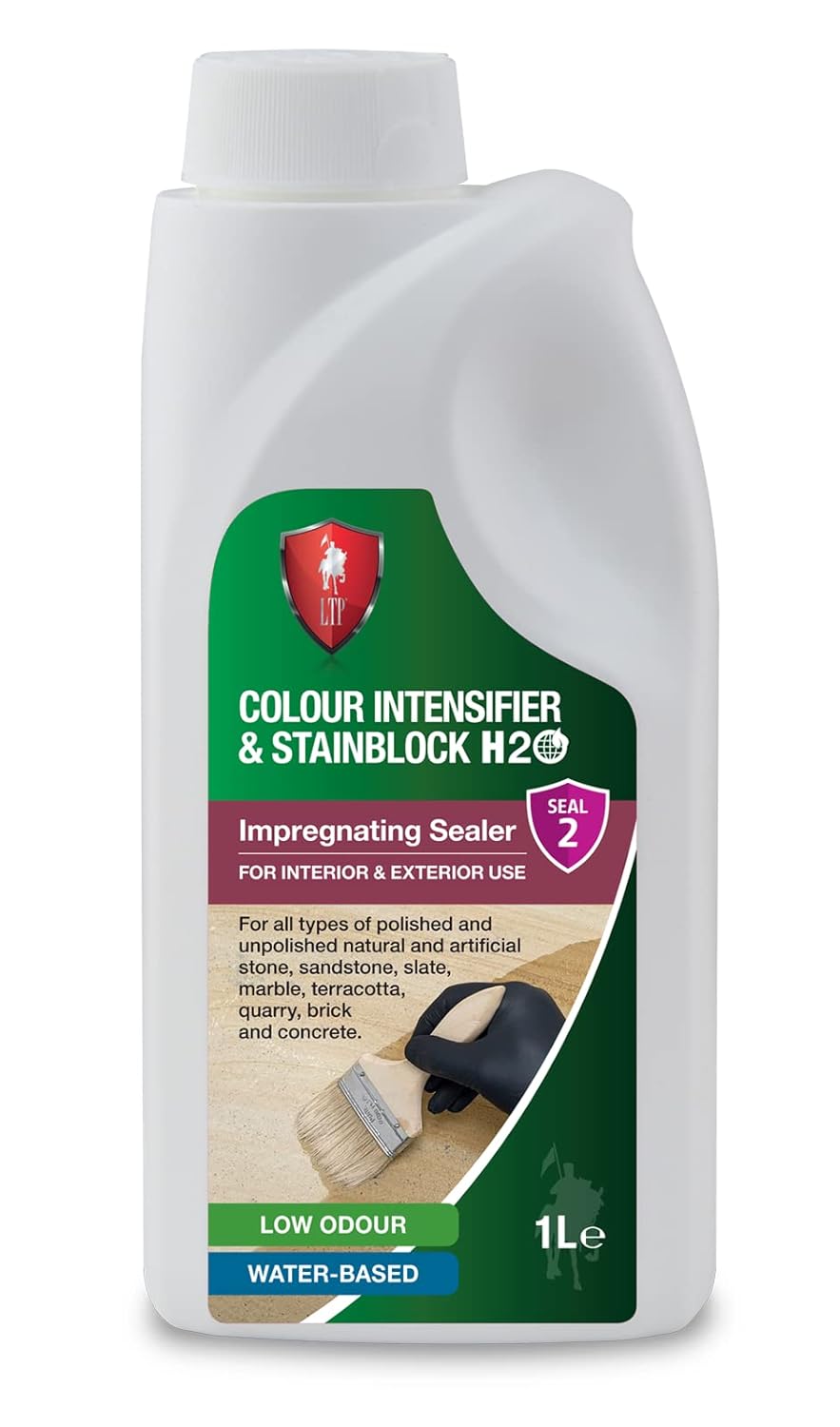
LTP Colour Intensifier & Stainblock H20
|

Vileda H2PrO Spin Mop System
|
Over time, however, these historical tiles often lose their visual impact due to surface wear, chemical effects, and environmental influences. Restoring their original vibrancy is a specialist task that necessitates an in-depth understanding of the materials, historically accurate techniques, and premium products designed specifically for heritage surfaces. Only through expert knowledge can one ensure that restoration not only brings back the visual beauty of the tiles but also maintains their structural integrity and historical significance, preserving their rich narratives for future appreciation.
Understanding Factors Leading to the Fading and Dulling of Victorian Mosaic Tiles
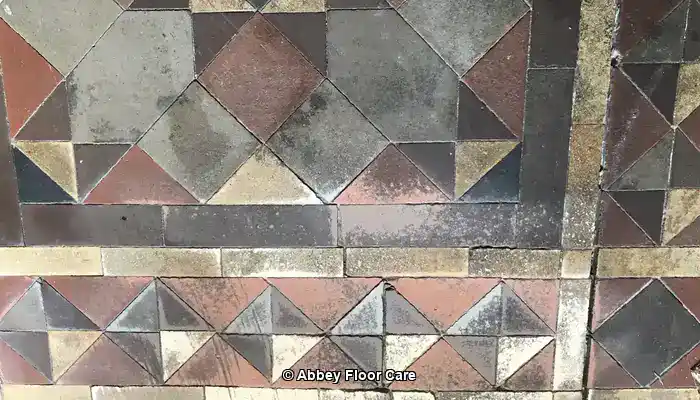
Example of Victorian Clay Tile Floor dulled through surface wear and damage.
Although the pigments are integral to the tile structure, various factors combine to contribute to fading and dulling over time:
- Accumulated dirt and grime: Continuous foot traffic leads to the deposition of fine particles and oils that infiltrate porous surfaces, scattering light and muting colours. This accumulation not only detracts from the aesthetic appeal but can also lead to long-term damage if not addressed promptly and effectively.
- Wax and polish buildup: Layers of wax or sealants that lack breathability trap moisture, resulting in a cloudy or yellowed appearance. This buildup can obscure the vibrant colours and intricate patterns that make these tiles unique and historically significant.
- Moisture-driven issues: Many Victorian tiles were installed over subfloors without damp-proof membranes, which can lead to rising damp that carries soluble salts. These salts crystallise on the tile surface as efflorescence, further obscuring the original tones and potentially damaging the tile structure irrevocably.
- Physical abrasion: Small surface scratches caused by years of wear disrupt smooth light reflection, diminishing the visual richness of the tiles. This physical damage can compound over time, making restoration efforts more challenging and demanding expert techniques to rectify.
Effective restoration requires a careful approach that addresses each of these contributors without compromising the historical integrity of the tiles. It is essential to adopt strategies that not only clean the surface but also restore the beauty and functionality of the tiles for the long term, ensuring they continue to be appreciated for their historical value.
Examining the Impact of Breathability on Victorian Tiles Without a Damp-Proof Membrane
Many Victorian tiled floors are laid on older subfloors that lack a damp-proof membrane (DPM), necessitating that their natural clay structure remains permeable to facilitate moisture evaporation from the subfloor. Non-breathable wax coatings or film-forming sealers obstruct this evaporation pathway, leading to moisture accumulation beneath the surface. This entrapment causes salts and humidity to build up, resulting in efflorescence, degradation of surface minerals, and the undesirable phenomenon known as wax blooming—a whitish haze on the tile. Therefore, restoration strategies must prioritize breathable impregnating sealers that protect tiles while allowing moisture vapour to escape freely, thus preventing long-term damage. Achieving this balance is crucial for maintaining the longevity and appearance of the tiles, ensuring their historical and aesthetic value remains intact.
Exploring Pigments and Tile Composition: An Essential Element of Restoration
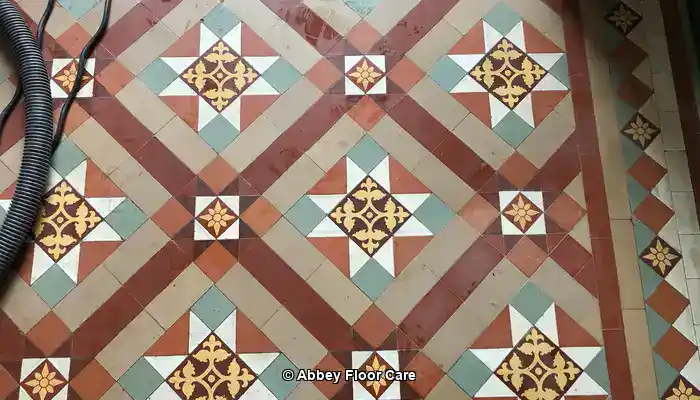
An example of different pigments in a Victorian Clay tile floor during restoration by Abbey Floor Care
The Significance of Mineral Oxide Pigments in Victorian Tiles
Victorian mosaic and encaustic tiles derive their distinctive earthy colours from mineral oxide pigments that are embedded directly into the clay. These pigments not only provide durability but also enhance the depth of colour, making each tile unique. The primary pigments found in these tiles include:
- Iron oxide: generates terracotta reds, rust browns, and soft ochres, contributing to the warm tones characteristic of Victorian designs and adding to their charm and historical value.
- Manganese: yields deep browns and rich blacks, enhancing contrast and depth in intricate patterns, making each tile a work of art that tells a story of its own.
- Cobalt: imparts varying blue hues, adding a cool tone that complements the overall colour palette, enhancing visual interest and aesthetic appeal.
- Chromium: creates natural green shades, providing an earthiness that balances the brighter hues and adds richness to the overall design, contributing to the historical authenticity.
Understanding the Firing and Fusion Process in Tile Production
During the manufacturing process, the tiles are fired at temperatures approaching 1100°C, vitrifying the clay and fusing the pigments deep into the tile body. This technique ensures that the colour permeates throughout the tile rather than simply resting on the surface, thus offering long-lasting vibrancy and resilience against wear. The intense heat transforms the raw materials, resulting in tiles that are not only visually captivating but also robust and enduring, making them a treasured aspect of architectural history that deserves preservation.
Characteristics of Porous Unglazed Finish in Victorian Tiles
Victorian tiles typically exhibit a porous, unglazed matte finish, which contributes to their natural appearance and tactile quality. However, this porosity also makes the tiles susceptible to absorption, rendering them sensitive to surface contamination and moisture. Thus, careful cleaning and maintenance practices are essential to preserve their condition and prevent damage. Understanding this characteristic aids in selecting appropriate cleaning agents and methods that will not compromise the tile’s integrity, ensuring their longevity and beauty are maintained for generations to come.
Variability in Colour Durability: Insights into Tile Composition
Natural earth pigments, particularly in red and yellow tiles, contain fewer mineral additives than darker colours like black, which are formulated with manganese. This difference indicates that red and yellow tiles are generally less hard-wearing and more prone to surface dishing under heavy traffic. Such wear presents as shallow depressions where footfall is concentrated, leading to uneven colour intensity and a loss of surface flatness. Recognising these patterns is vital for tailoring restoration methods that effectively address and repair these issues, ensuring that the tiles retain their historical significance and beauty.
Key Considerations for Effective Restoration Planning
Grasping the composition of pigments and the wear patterns of tiles is crucial in restoration planning. Softer-toned tiles necessitate gentler cleaning methods and tailored impregnating sealers that respect their physical properties while enhancing colour. Conversely, darker, harder tiles can withstand more intensive cleaning but still require breathable, colour-enhancing protection to maintain vibrancy over time. This nuanced understanding allows restorers to apply the best methods and products for each specific tile type, ensuring optimal results that respect and preserve the tiles’ integrity.
Implementing Effective Restorative Cleaning Techniques for Victorian Mosaic Tiles
Thorough cleaning is fundamental to restoring Victorian encaustic and mosaic tiles to their original vibrancy. However, cleaning these tiles requires a specialised approach that transcends the use of standard pH-neutral detergents typically recommended. Professional restorers utilise precisely formulated alkaline cleaners and mechanical techniques to dissolve heavy soiling and old residues without compromising the historic integrity of the tile fabric. The choice of cleaning agents plays a pivotal role in the restoration process, ensuring that the tiles can be rejuvenated while retaining their original features and characteristics.
Debris Removal: The Crucial First Step in Cleaning
The cleaning process commences with the removal of all loose dirt and grit using soft brushes or vacuuming with brush attachments. This initial step is crucial to preventing scratches on the delicate tile surfaces during subsequent cleaning phases, ensuring that the original finish remains intact. A clean surface is vital for effective deep cleaning, as it allows the cleaning agents to work more efficiently and achieve better results, enhancing the overall restoration outcome.
Utilising Alkaline Cleaners for Intensive Soil Removal Effectively
Unlike pH-neutral cleaners, which may lack the chemical strength required to tackle ingrained fatty acids and organic soils, alkaline cleaners are indispensable for thoroughly breaking down household oils, grease, and sticky residues commonly found on tile surfaces and grout lines. These alkaline formulations effectively dissolve the binding agents of dirt, sugars, and fats, facilitating their efficient removal while preserving compatibility with the mineral composition of Victorian tiles. The use of the right cleaners ensures that the restoration process is both effective and safe for the tiles, maintaining their integrity and historical value.
Professional-use alkaline products, such as PS87 PRO or tailored formulations from heritage cleaning specialists, are typically used in diluted forms. This method ensures deep cleaning without excessively aggressive actions towards the clay body. It is also vital to remember that even when using alkaline cleaners, caution is paramount, and spot testing is highly recommended to avoid any adverse reactions that could harm the tiles.
Mechanical Agitation: Enhancing Cleaning Effectiveness through Technique
Mechanical action significantly improves cleaning efficacy. Low-speed rotary scrubbers fitted with red or, occasionally, green non-abrasive pads are commonly employed to agitate soils out of small pits, tile surfaces, and grout lines. These pads deliver thorough cleaning while safeguarding the integrity of tile edges and delicate surface details, ensuring that the restoration process is both effective and gentle. This mechanical action complements the chemical cleaners, enhancing overall results and restoring the tiles’ original beauty and vibrancy.
Targeted Removal of Waxes and Exotic Sealants for Optimal Restoration
Years of use often lead to the accumulation of old waxes and sealants, particularly from DIY attempts using inappropriate products. Water-based cleaners, either alkaline or mildly acidic, are preferred for safely removing these residues without damaging the tile’s mineral structure. However, stubborn ‘exotic’ or solvent-resistant coatings necessitate the use of targeted solvent-based removers such as Lithofin Wax-Off or LTP Solvex. These solvents effectively soften and emulsify waxes and old sealants, but must be handled carefully by trained professionals to ensure safe application and disposal. This precision is crucial to prevent any damage during the cleaning process and maintain the tiles’ historical value and beauty.
Thorough Rinsing and Drying: A Crucial Final Step in Restoration
Following chemical cleaning, thorough rinsing is critical to eliminate all cleaning residues. Multiple rinses with clean water, complemented by wet vacuum extraction, ensure that no traces of detergent or solvent remain, which could interfere with subsequent restoration coatings. Drying time varies depending on environmental conditions, such as humidity, surface type, and moisture content. Restoration experts consistently utilise moisture meters to confirm that the tiles are fully dry before applying any impregnating sealers or protective treatments. This meticulous approach prevents moisture entrapment, which could lead to efflorescence, staining, or damage beneath sealed layers. Ensuring that the tiles are completely dry is essential for the success of the restoration process, preserving their aesthetic appeal and longevity.
Benefits of Comprehensive Cleaning in the Restoration Process
Thorough cleaning reveals the true condition of the tiles by eliminating visual obstructions. It exposes areas that may require repair and provides a clean, receptive surface for colour-enhancing impregnators or other restorative products. This careful preparation is fundamental to the success and longevity of Victorian mosaic tile restoration, ensuring that the revitalised tiles maintain their beauty and integrity for years to come. Without comprehensive cleaning, restoration efforts may not achieve the desired aesthetic or functional outcomes, leading to future complications and degrading the historical value of the tiles.
Achieving Stunning Colour Enhancement with Premium Impregnating Sealers
Restoration professionals utilise colour-enhancing impregnating sealers manufactured by <a href=”https://amzn.to/40G0qka”>LTP</a> and Lithofin, brands renowned for their advanced, heritage-approved formulations. Unlike superficial coatings, these sealers:
- Penetrate deeply into tile pores to physically enhance colour by altering light refraction, thus making the tiles appear more vibrant and rich in hue, effectively reviving their original brilliance.
- Maintain vapour permeability, which is crucial for moisture escape, particularly in older floors devoid of DPM layers. This characteristic helps prevent moisture-related damage over time, ensuring tile durability and preserving their historical value.
- Provide enduring protection against stains and foot traffic without altering the natural texture or gloss of the tiles. This ensures that the tiles remain true to their original appearance, enhancing their historical significance and aesthetic appeal.
- They are applied in multiple light coats, with each coat allowed to penetrate before the next is applied, ensuring complete uniformity and effectiveness. This method guarantees that the restoration is thorough and long-lasting, safeguarding the tiles’ integrity and vibrancy.
These sealers directly combat fading by restoring vibrancy while preserving the breathable nature of the historic floor. Their application is a key step in revitalising the beauty of Victorian mosaic tiles, ensuring they remain a cherished aspect of heritage for years to come.
Conducting Physical Repairs for Damaged Tiles and Implementing Colour Tinting Techniques
Tiles that exhibit chips, cracks, or missing pieces necessitate careful repair using tinted epoxy or lime-based mortars, colour-matched with natural mineral oxides for authenticity. Restoration experts source matching replacement tiles from salvage archives to preserve pattern continuity, ensuring that repairs are seamless and historically accurate. Colour tinting involves the selective application of wax or resin mixtures infused with earth pigments to gently blend worn or missing pattern areas while respecting the tiles’ breathability and reversibility. This meticulous attention to detail is crucial for maintaining the authenticity of the restored tiles, allowing their historical significance to shine through and be appreciated by future generations.
Best Practices for Effective Tinting in Tile Restoration
- Utilise small, controlled applications to avoid overwhelming the original colouring. This precision is essential for achieving a natural look that respects the tile’s integrity and enhances its historical value.
- Conduct patch testing on inconspicuous areas before full application to ensure compatibility. This step helps prevent unexpected reactions that could harm the tiles and ensure a successful restoration outcome.
- Ensure that the tinting materials are compatible with the impregnating sealers applied to the entire surface. This compatibility is key for achieving a cohesive finish that enhances the overall aesthetic and integrity of the tiles.
Strategies for Maintaining Restored Victorian Mosaic Floors for Longevity
Preserving the restored colour and condition of Victorian mosaic tiles requires ongoing care and attention:
- Routine cleaning with pH-neutral, non-abrasive detergents specifically designed for historic tiles. This gentle approach helps maintain the tiles’ integrity and prevents deterioration, ensuring their beauty lasts.
- Implement preventive measures, such as placing entrance mats to minimise dirt ingress and protect the tiles. This proactive strategy can significantly reduce wear and tear, prolonging the life of the tiles and maintaining their visual appeal.
- Promptly address liquid spills, especially acidic substances like vinegar or wine, to prevent surface etching. Quick action can prevent long-term damage and maintain the tiles’ aesthetic allure.
- Regularly reapply breathable impregnating sealers every 3–5 years or as wear dictates to maintain protection. This routine is essential for longevity and preserving the tiles’ historical value and visual integrity.
- Monitor floors for signs of efflorescence or moisture ingress, which can indicate underlying damp issues that need to be addressed. Early detection can prevent extensive damage and ensure the tiles remain in optimal condition for years to come.
Avoiding Common Pitfalls in Tile Restoration Projects: Essential Tips
- Avoid wax treatments that can impede breathability, cause efflorescence, or lead to wax blooming. Such treatments can damage the tiles in the long run and compromise their integrity, leading to costly repairs.
- Do not utilise acrylic or polyurethane sealants that trap moisture and promote degradation. These materials can compromise the tiles’ integrity and lead to deterioration, significantly impacting their historical value.
- Limit the application of harsh chemical cleaners, as they can erode the clay and pigments. Using milder alternatives is advisable for preservation and maintenance of the tiles’ beauty and authenticity.
- Never repaint tiles; paint films alter their visual and physical properties and are not reversible. This can detract from their historical value and compromise authenticity, making it difficult to restore them accurately.
- Recognise and address issues in older subfloors before sealing to prevent future complications. Understanding the foundation is key to successful restoration and maintaining the integrity of the tiles and the floor.
Highlighting Real-World Restoration Projects and Their Impact on Heritage Preservation
Case studies illustrate the successful application of these restoration principles:
Restoration of a Victorian Hallway in Sheffield: A Case Study
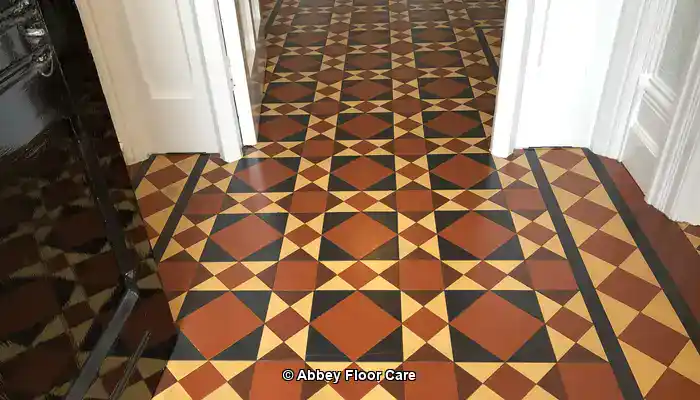
Our comprehensive cleaning removed years of wax and grime, followed by the application of Lantania Avo, a colour-enhancing impregnating sealer that noticeably deepened the tile colours. This was further complemented with an acrylic topical sealer to provide surface protection for floors installed over a damp-proof membrane. The end result was a beautifully restored floor that showcased the original vibrancy of the tiles, preserving their historical significance and beauty for future generations to admire.
Restoration of a Civic Mosaic Floor in Chesterfield: A Successful Example
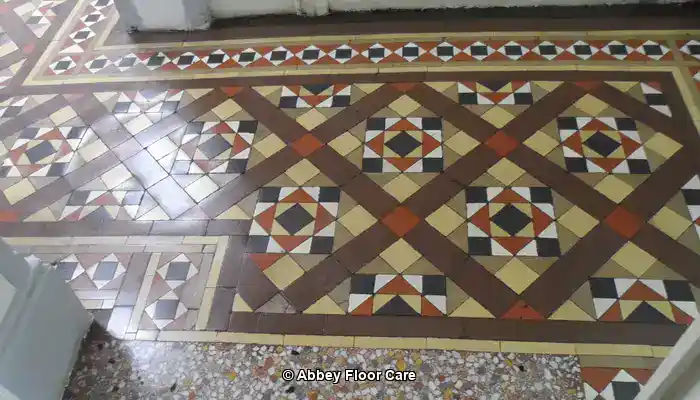
After cleaning and removing old topical sealers, the floor was sealed with an LTP Colour Enhancing Impregnating Sealer. The surface was further protected with a wax, carefully applied to seamlessly integrate the clay tiles into the historic fabric of the building. This project reaffirmed the importance of maintaining the aesthetic and historical integrity of civic spaces, ensuring their longevity and continued appreciation by the community.
Preserving Heritage Through Expert Restoration Practices: A Commitment to Excellence
Restoring the colour and pigment of Victorian mosaic tiles is an intricate task that balances material science, craftsmanship, and sensitivity to heritage values. By employing premium impregnating colour-enhancing sealers from industry leaders such as Dry Treat, Lantania, and Lithofin, we ensure long-term breathability, protection, and vibrancy of colour. Skilled cleaning, meticulous repair, and dedicated maintenance help to maintain authenticity while rejuvenating these historic floors for future generations to appreciate. This commitment to excellence ensures that the beauty and history of these tiles endure, showcasing their significance in architectural heritage and cultural narratives.
Frequently Asked Questions About Victorian Tile Restoration: All You Need to Know
What are Victorian mosaic tiles?
Victorian mosaic tiles are decorative tiles that gained popularity in the 19th century, recognised for their vibrant colours and intricate patterns. They were commonly utilised in both public buildings and private homes, adding charm and character to various spaces through their unique designs and artistic expression.
How can I effectively restore faded Victorian mosaic tiles?
The restoration of faded Victorian mosaic tiles involves a combination of cleaning, repairing damages, applying new pigments to match the original colours, and subsequently sealing the tiles to ensure long-lasting protection. This comprehensive approach is crucial for achieving satisfactory results and preserving their historical value and visual appeal.
What materials are essential for tile restoration?
Key materials for tile restoration include specialised cleaning solutions, pigments, adhesives, grout, and protective sealants, all selected for their compatibility with the original tiles to maintain authenticity. The right materials ensure that the restoration process respects the original craftsmanship and enhances the tiles’ beauty and historical significance.
How long does the tile restoration process typically take?
The timeline for tile restoration varies based on the size and condition of the area being restored, typically ranging from a few days for smaller projects to several weeks for larger restorations, as careful attention to detail is crucial for achieving the best outcomes and preserving integrity and historical value.
Can I undertake the restoration myself?
Yes, smaller restoration projects can be tackled as DIY if you possess the necessary skills and tools; however, more complex repairs often require professional expertise to ensure quality results and avoid potential pitfalls. Professional help can provide peace of mind and a higher quality finish, ensuring the preservation of the tiles and their historical value.
What is the cost associated with restoring Victorian mosaic tiles?
Costs can fluctuate significantly based on project size and condition, generally ranging from a few hundred to several thousand pounds for comprehensive restoration efforts, reflecting the level of detail and care involved. Understanding the potential costs helps in planning the restoration effectively and ensuring that the project is feasible within budget considerations.
How do I select the right restoration expert?
Seek out restoration professionals with proven experience in historical projects, positive reviews, and a commitment to employing authentic materials and techniques that respect the heritage of the tiles. This ensures that the restoration will be handled with the necessary care and expertise, preserving the tiles’ historical significance and enhancing their aesthetic appeal.
What challenges do restorers commonly encounter during tile restoration?
Restorers often face challenges such as matching original colours, repairing damaged tiles, and ensuring the durability of the restoration work to withstand time and use. These challenges require skill and experience to overcome, making expert knowledge invaluable in the restoration process and ensuring that the tiles maintain their integrity.
What are the best practices for maintaining restored tiles?
Regular cleaning with pH-neutral products, avoiding harsh chemicals, resealing periodically, and promptly addressing any damage are all critical practices for maintaining the condition of restored tiles over time. These practices help extend the life of the restoration and ensure that the tiles remain beautiful and true to their historical significance.
What innovations are currently present in tile restoration practices?
Recent innovations include advanced cleaning solutions, new types of sealants that enhance breathability, and digital technology for precise colour matching and pattern replication in restoration projects, enhancing the effectiveness and efficiency of restoration efforts. Staying informed about these innovations can improve restoration outcomes and maintain the integrity of the tiles for future appreciation.
The Article Revitalising Colour and Pigment in Victorian Mosaic Tiles first found on https://www.abbeyfloorcare.co.uk
The Article Restoring Colour to Faded Victorian Mosaic Tiles appeared first on https://fabritec.org
The Article Restoring Faded Victorian Mosaic Tiles to Vibrant Color Was Found On https://limitsofstrategy.com
The Article Restoring Victorian Mosaic Tiles to Their Vibrant Glory First Appeared ON
: https://ad4sc.com
No responses yet